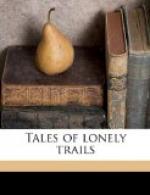V
It rained the following day, making a good excuse to stay in camp and rest beside the little tent-stove. And the next morning I started out on foot with Copple. We went down Beaver Dam Canyon intending to go up on the ridge where R.C. and I had seen the flock of turkeys.
I considered Copple an addition to my long list of outdoor acquaintances in the west, and believed him a worthy partner for Nielsen. Copple was born near Oak Creek, some twenty miles south of Flagstaff, and was one-fourth Indian. He had a good education. His whole life had been in the open, which fact I did not need to be told. A cowboy when only a boy he had also been sheepherder, miner, freighter, and everything Arizonian. Eighteen years he had hunted game and prospected for gold in Mexico. He had been a sailor and fireman on the Pacific, he had served in the army in the Philippines. Altogether his had been an adventurous life; and as Doyle had been a mine of memories for me so would Copple be a mine of information. Such men have taught me the wonder, the violence, the truth of the west.
Copple was inclined to be loquacious—a trait that ordinarily was rather distasteful to me, but in his case would be an advantage. On our way down the canyon not only did he give me an outline of the history of his life, but he talked about how he had foretold the storm just ended. The fresh diggings of gophers—little mounds of dirt thrown up—had indicated the approach of the storm; so had the hooting of owls; likewise the twittering of snowbirds at that season; also the feeding of blackbirds near horses. Particularly a wind from the south meant storm. From that he passed to a discussion of deer. During the light of the moon deer feed at night; and in the day time they will lie in a thicket. If a hunter came near the deer would lower their horns flat and remain motionless, unless almost ridden over. In the dark of the moon deer feed at early morning, lie down during the day, and feed again toward sunset, always alert, trusting to nose more than eyes and ears.
Copple was so interesting that I must have passed the place where R.C. and I had come down into the canyon; at any rate I missed it, and we went on farther. Copple showed me old bear sign, an old wolf track, and then fresh turkey tracks. The latter reminded me that we were out hunting. I could carry a deadly rifle in my hands, yet dream dreams of flower-decked Elysian fields. We climbed a wooded bench or low step of the canyon slope, and though Copple and I were side by side I saw two turkeys before he did. They were running swiftly up hill. I took a snap shot at the lower one, but missed. My bullet struck low, upsetting him. Both of them disappeared.
Then we climbed to the top of the ridge, and in scouting around along the heavily timbered edges we came to a ravine deep enough to be classed as a canyon. Here the forest was dark and still, with sunlight showing down in rays and gleams. While hunting I always liked to sit down here and there to listen and watch. Copple liked this too. So we sat down. Opposite us the rocky edge of the other slope was about two hundred yards. We listened to jays and squirrels. I made note of the significant fact that as soon as we began to hunt Copple became silent.




